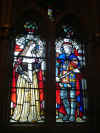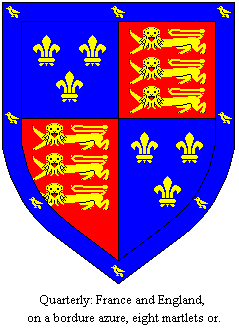Jasper
TUDOR
(D. Bedford)

Catherine
Woodville and Jasper Tudor
Stained
Glass at Cardiff Castle
Uncle of King Henry
VII of England and the architect of his successful conquest of England
and Wales in 1485. Jasper was the third son of Owen Tudor and the
former queen Catherine of Valois, widow of King Henry V. Hence he
was a half-brother to King Henry VI, who, on attaining his majority,
created Jasper Earl of Pembroke. His brother Edmund was made the
Earl of Richmond. The following year the brothers were given joint custody of
the rich heiress Margaret Beaufort,
and in 1455 Edmund married her.
Jasper was an adventurer whose military expertise, some of it
gained in the early stages of the Wars of the Roses, was considerable. Although there was uncertainty as to
whether Jasper and his two (or three) brothers were legitimate, their
parents' probably secret marriage not being recognised by the authorities, he
enjoyed all the privileges appropriate to his birth until 1461, when he was
subject to an attainder for supporting King Henry VI against the Yorkists
who eventually deposed him.
Jasper fought in Henry VI’s army at the Battle of St.
Albans in May 1455, where the royal army was beaten and Henry himself
captured. Jasper survived the battle and attempted to reconcile the
warring factions. He was briefly successful as the rebel lords renewed their
oaths of allegiance to King Henry, but fighting soon broke out again. In
1456 his brother Edmund Tudor was captured by the Yorkists and died of an
illness contracted in prison, leaving his young widow with an unborn child.
War resumed in 1459 when the Duke of York returned from
exile in Ireland. Jasper was ordered to seize Denbigh Castle to block
York’s lines of communication between England and Ireland, which he did
successfully. Disaster struck when the Yorkists met and defeated King Henry’s
forces at Northampton in Jul 1460. Jasper was left isolated at Denbigh
but refused to surrender. A Yorkist army stormed Denbigh but Jasper
managed to escape and join up with Lancastrians in Wales. He
remained in touch with Margaret of Anjou, queen of Henry VI, as
she struggled to regain her son's Edward inheritance.
The fortunes of war now swung in Lancaster’s favour as the Duke of
York was ambushed and killed by Lancastrian forces at Wakefield and his army
wiped out. The Lancastrians then marched south and defeated another Yorkist army
at St. Albans while Jasper Tudor helped to gather an army in Wales. In
early 1461 the Welsh force, which included Jasper’s father, Owen
Tudor, marched to the borders of Herefordshire to face an army led by the Duke
of York’s son Edward.
The ensuing battle at Mortimer’s Cross was noted for the appearance of
three suns in the sky. Jasper’s army was defeated and in memory of
their victory the Yorkists adopted the image of the sun as a symbol. Jasper
escaped but sadly his father was captured and executed in the market place at
Hereford. His last words were ‘This head shall lie on the block that once
lay in Queen Catherine’s lap’.
Soon after Mortimer’s Cross the main Lancastrian army was exterminated
in a colossal battle at Towton in Yorkshire. Edward marched to London and
was crowned King Edward IV, while Jasper fled to Ireland and spent
the next few years living as a hunted fugitive. He reappeared in 1468, landing
in North Wales to try and relieve Harlech Castle (the valiant defence of the
garrison was the inspiration for the song ‘Men of Harlech’). Jasper
was attainted, and William, Lord Herbert, created Earl of Pembroke in his
room, his patent expressing, that he had that honour for expelling Jasper
the rebel. The
custody of Jasper’s nephew,
Henry Tudor was taken over by William Herbert.
Jasper was involved in another Lancastrian invasion in 1470, and
this one was more successful as Edward IV’s soldiers deserted him and
he was forced to flee abroad. Henry VI was brought out of imprisonment
and restored as King. Jasper was restored to the earldom of Pembroke, but
the mental health of Henry VI, he had always been weak, now completely
failed. He did have one moment of prophetic lucidity, for when Jasper
brought his young nephew Henry Tudor
to court King Henry declared that the boy would one day rule England.
Henry VI’s restoration was short-lived as in 1471 Edward
returned with a new army. The war was finally decided by two dreadful battles at
Barnet and Tewkesbury, which resulted in the virtual destruction of the
Lancastrian cause. Jasper lost his earldom a second time, which being
surrendered by the second William Herbert to Edward IV, that king
gave it to his son prince Edward, who enjoyed it during life. Henry VI
was murdered soon after, his son Edward, Prince of Wales, had died at Tewkesbury,
leaving Jasper’s nephew Henry Tudor
as the sole surviving Lancastrian claimant to the throne. Henry’s
life was preserved by Jasper, who fled with him to Brittany where they
spent the next thirteen years in exile
It was thanks to him that
Henry acquired the tactical awareness that made it possible to defeat
the far more experienced Richard III at the Battle of
Bosworth. On
Henry's accession in 1485, Jasper was restored to all his former
titles, including Knight of the Garter. He was also made high steward at the
coronation of Queen Elizabeth.
The next year he made him lieutenant of Ireland for one year. He was created Duke of Bedford and
married the former Catherine Woodville, sister of Queen Elizabeth
Woodville and widow of the Duke of Buckingham. In 1486, he helped
suppress the Lovel/Stafford revolt near York. In 1488, he took
possession of Cardiff Castle. In 1487, he fought at the Battle
of Stoke. In 1492, he fought in France and was made Earl Marshal, office
granted to him and to the heirs male of his body.
He died in Dec 1495, and was buried at Keynsham
Abbey in Somerset, where he had founded a chantry for four priests, to sing mass
for his father, Catherine his mother, and Edmund his elder brother.




